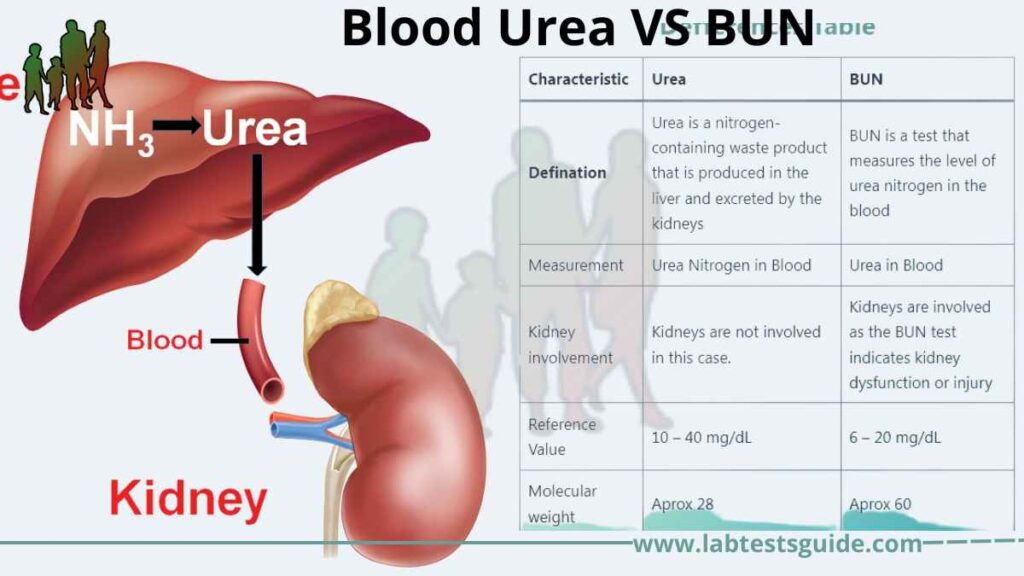Urea VS BUN: Urea and BUN (blood urea nitrogen) are related but different markers of kidney function. Urea is a waste product that is formed in the liver and excreted by the kidneys. BUN is a measure of the amount of urea nitrogen present in the blood. High levels of BUN can indicate kidney dysfunction or dehydration, while high levels of urea can also indicate liver disease or other conditions. So BUN is a measure of urea in blood, therefore, a BUN test is a measure of the level of urea in the blood, which is a waste product of protein metabolism and is excreted by the kidney.

Definations:
Urea:
Urea is a nitrogen-containing waste product that is produced in the liver and excreted by the kidneys. It is a byproduct of protein metabolism and is commonly measured in blood tests to assess kidney function. High levels of urea can indicate renal failure or other kidney problems, liver disease, or certain metabolic disorders.
BUN (Blood Urea Nitrogen):
BUN stands for Blood Urea Nitrogen. It is a test that measures the level of urea nitrogen in the blood. Urea nitrogen is a waste product that is produced in the liver and excreted by the kidneys. BUN test is often used to evaluate kidney function, and high levels can indicate kidney dysfunction, dehydration, or other conditions. It is a simple blood test and gives an idea of how well the kidneys are working.
What are Differances between Urea and BUN
Here are some of the key differences between urea and BUN:
- Urea is a waste product formed in the liver, while BUN is a measure of the amount of urea nitrogen present in the blood.
- Urea is excreted by the kidneys, while BUN is a measure of the urea present in the blood.
- High levels of BUN can indicate kidney dysfunction or dehydration, while high levels of urea can also indicate liver disease or other conditions.
- BUN test is often used to evaluate kidney function, while urea level is also used to evaluate kidney function but also give an idea of how well the liver is working.
- Urea level can be affected by many factors such as age, sex, diet, and overall health, while BUN is mainly affected by kidney functions.
- BUN test is a simple blood test, while urea test is also a simple blood test but it can also be measured in urine.
- Normal range for urea is typically between 10 and 40 mg/dL, and for BUN it is typically between 6 and 20 mg/dL.
- The interpretation of the results of both urea and BUN should always be done by a healthcare professional and in the context of the patient’s clinical picture.
Similarities Between BUN and Urea:
- Both BUN (blood urea nitrogen) and urea are waste products of protein metabolism in the body.
- Both are excreted by the kidneys in the urine.
- Elevated levels of both BUN and urea can indicate kidney dysfunction or dehydration.
- Both BUN and urea levels can be measured through a blood test.
- High levels of both BUN and urea can be caused by a high protein diet, certain medications, or underlying medical conditions.
Defferences Table
| Characteristic | Urea | BUN |
|---|---|---|
| Defination | Urea is a nitrogen-containing waste product that is produced in the liver and excreted by the kidneys | BUN is a test that measures the level of urea nitrogen in the blood |
| Measurement | Urea Nitrogen in Blood | Urea in Blood |
| Kidney involvement | Kidneys are not involved in this case. | Kidneys are involved as the BUN test indicates kidney dysfunction or injury |
| Reference Value | 10 – 40 mg/dL | 6 – 20 mg/dL |
| Molecular weight | Aprox 28 | Aprox 60 |
Conclusion of Urea and BUN :
In conclusion, Urea and BUN are related markers of kidney function. Urea is a waste product produced in the liver and excreted by the kidneys, while BUN is a measure of the amount of urea nitrogen present in the blood. High levels of BUN and urea can indicate kidney dysfunction or dehydration, or other conditions such as liver disease.
BUN test is often used to evaluate kidney function, and high levels can indicate kidney dysfunction, dehydration, or other conditions. The normal range for urea is typically between 10 and 40 mg/dL, and for BUN it is typically between 6 and 20 mg/dL. However, these values can vary depending on the lab and the specific test method used and always need to be interpreted in the context of the patient’s clinical picture.
FAQs
What is the difference between urea and BUN?
Urea is a waste product formed in the liver, while BUN is a measure of the amount of urea nitrogen present in the blood. Urea is excreted by the kidneys, while BUN is a measure of the urea present in the blood. High levels of BUN can indicate kidney dysfunction or dehydration, while high levels of urea can also indicate liver disease or other conditions.
How is BUN test used to evaluate kidney function?
BUN (blood urea nitrogen) test measures the level of urea nitrogen in the blood, which is a waste product of protein metabolism and is excreted by the kidney. High levels of BUN can indicate kidney dysfunction or dehydration.
What is the normal range for urea and BUN?
The normal range for urea is typically between 10 and 40 mg/dL, and for BUN it is typically between 6 and 20 mg/dL. However, these values can vary depending on the lab and the specific test method used.
How can high levels of urea and BUN be treated?
Treatment for high levels of urea and BUN depends on the underlying cause. If kidney dysfunction is the cause, treatment may include medications to improve kidney function, fluid therapy, and/or dialysis. If liver disease is the cause, treatment may include medications to control symptoms and/or surgery.
What are the factors that affect urea level?
Urea level can be affected by many factors such as age, sex, diet, and overall health, while BUN is mainly affected by kidney functions.
How should the results of urea and BUN test be interpreted?
The interpretation of the results of both urea and BUN should always be done by a healthcare professional and in the context of the patient’s clinical picture.
Possible References Used







